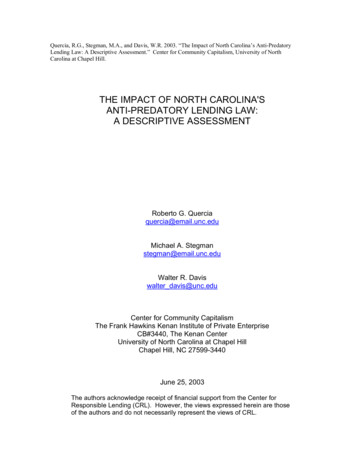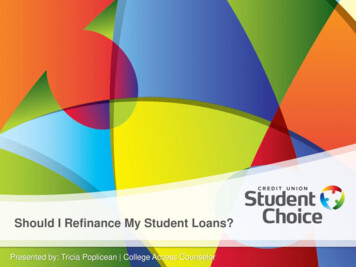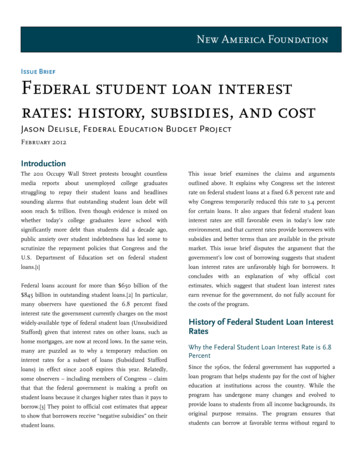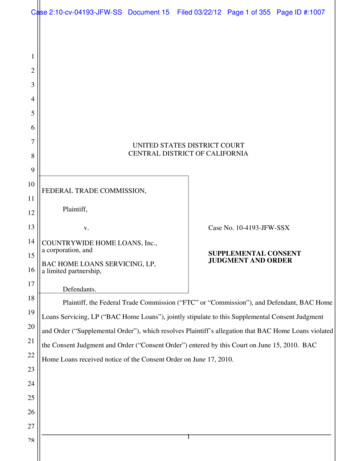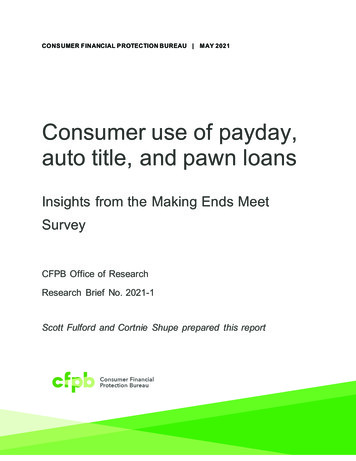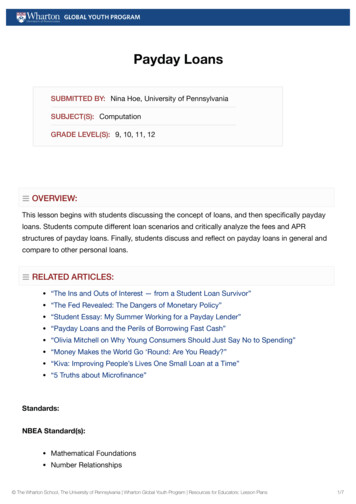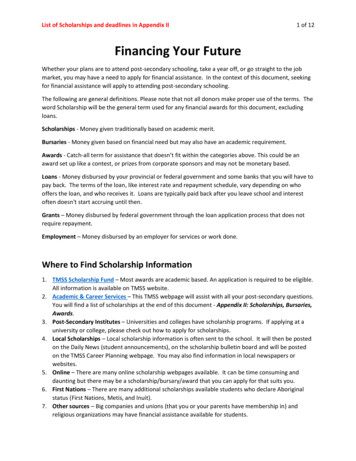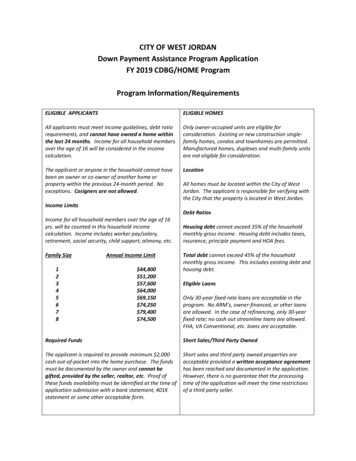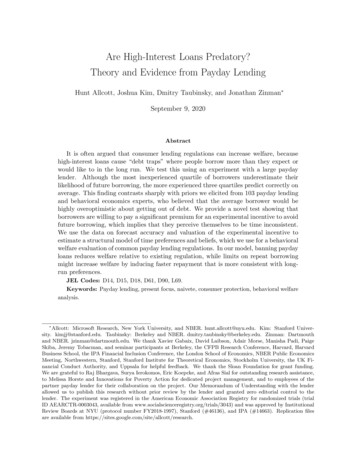
Transcription
Are High-Interest Loans Predatory?Theory and Evidence from Payday LendingHunt Allcott, Joshua Kim, Dmitry Taubinsky, and Jonathan Zinman September 9, 2020AbstractIt is often argued that consumer lending regulations can increase welfare, becausehigh-interest loans cause “debt traps” where people borrow more than they expect orwould like to in the long run. We test this using an experiment with a large paydaylender. Although the most inexperienced quartile of borrowers underestimate theirlikelihood of future borrowing, the more experienced three quartiles predict correctly onaverage. This finding contrasts sharply with priors we elicited from 103 payday lendingand behavioral economics experts, who believed that the average borrower would behighly overoptimistic about getting out of debt. We provide a novel test showing thatborrowers are willing to pay a significant premium for an experimental incentive to avoidfuture borrowing, which implies that they perceive themselves to be time inconsistent.We use the data on forecast accuracy and valuation of the experimental incentive toestimate a structural model of time preferences and beliefs, which we use for a behavioralwelfare evaluation of common payday lending regulations. In our model, banning paydayloans reduces welfare relative to existing regulation, while limits on repeat borrowingmight increase welfare by inducing faster repayment that is more consistent with longrun preferences.JEL Codes: D14, D15, D18, D61, D90, L69.Keywords: Payday lending, present focus, naivete, consumer protection, behavioral welfareanalysis. Allcott: Microsoft Research, New York University, and NBER. hunt.allcott@nyu.edu. Kim: Stanford University. kimjj@stanford.edu. Taubinsky: Berkeley and NBER. dmitry.taubinsky@berkeley.edu. Zinman: Dartmouthand NBER. jzinman@dartmouth.edu. We thank Xavier Gabaix, David Laibson, Adair Morse, Manisha Padi, PaigeSkiba, Jeremy Tobacman, and seminar participants at Berkeley, the CFPB Research Conference, Harvard, HarvardBusiness School, the IPA Financial Inclusion Conference, the London School of Economics, NBER Public EconomicsMeeting, Northwestern, Stanford, Stanford Institute for Theoretical Economics, Stockholm University, the UK Financial Conduct Authority, and Uppsala for helpful feedback. We thank the Sloan Foundation for grant funding.We are grateful to Raj Bhargava, Surya Ierokomos, Eric Koepcke, and Afras Sial for outstanding research assistance,to Melissa Horste and Innovations for Poverty Action for dedicated project management, and to employees of thepartner payday lender for their collaboration on the project. Our Memorandum of Understanding with the lenderallowed us to publish this research without prior review by the lender and granted zero editorial control to thelender. The experiment was registered in the American Economic Association Registry for randomized trials (trialID AEARCTR-0003043, available from www.socialscienceregistry.org/trials/3043) and was approved by InstitutionalReview Boards at NYU (protocol number FY2018-1997), Stanford (#46136), and IPA (#14663). Replication filesare available from https://sites.google.com/site/allcott/research.
“The most hated sort [of wealth-getting], and with the greatest reason, is usury, whichmakes a gain out of money itself, and not from the natural object of it.”–Aristotle (Politics)“No man of ripe years and of sound mind, acting freely, and with his eyes open, oughtto be hindered . in the way of obtaining money, as he thinks fit.”–Jeremy Bentham (Defense of Usury, Letter 1, 1787)People have long questioned the ethics and social consequences of high-interest lending. Indeed,usury laws and other high-interest lending restrictions are among the oldest and most prevalentforms of consumer protection regulation. However, the extent to which such regulation actuallybenefits or harms consumers is still poorly understood. We study this issue in the context of paydaylending in the United States.Critics argue that payday loans are predatory, trapping consumers in cycles of repeated highinterest borrowing. A typical payday loan incurs 15 interest per 100 borrowed over two weeks,implying an annual percentage rate (APR) of 391 percent, and more than 80 percent of paydayloans nationwide in 2011-2012 were reborrowed within 30 days (CFPB 2016). As a result of theseconcerns, 18 states now effectively ban payday lending (CFA 2019), and in 2017, the ConsumerFinancial Protection Bureau (CFPB) finalized a set of nationwide regulations. The CFPB’s thendirector argued that “the CFPB’s new rule puts a stop to the payday debt traps that have plaguedcommunities across the country. Too often, borrowers who need quick cash end up trapped in loansthey can’t afford” (CFPB 2017).Proponents argue that payday loans serve a critical need: people are willing to pay high interestrates because they very much need credit. For example, Knight (2017) wrote that the CFPBregulation “will significantly reduce consumers’ access to credit at the exact moments they need itmost.” Under new leadership, the CFPB has rescinded part of its 2017 regulation on the groundsthat it would reduce credit access.At the core of this debate is the question of whether borrowers act in their own best interest.If borrowers successfully maximize their utility, then restricting choice reduces welfare. However,if borrowers have self-control problems (“present focus,” in the language of Ericson and Laibson2019), then they may borrow more to finance present consumption than they would like to in thelong run. Furthermore, if borrowers are “naive” about their present focus, overoptimistic abouttheir future financial situation, or for some other reason do not anticipate their high likelihood ofrepeat borrowing, they could underestimate the costs of repaying a loan. In this case, restrictingcredit access might make borrowers better off.We designed and implemented an experiment with a large payday lender (henceforth, the“Lender”) to answer two basic questions. First, do borrowers anticipate the extent of their repeat borrowing? Second, do borrowers perceive themselves to be time consistent? Our experimentprovides model-free evidence on these questions and also identifies a structural model of presentfocus with partially naive beliefs—one of the first such estimates outside of laboratory experiments.1
We then use our structural estimates as inputs to welfare analysis of three common payday lendingregulations—the first such analysis that accounts for key potential behavioral biases motivatingthese regulations.Our experiment ran from January to March 2019 in 41 of the Lender’s storefronts in Indiana,a state with fairly standard lending regulations. Customers taking out payday loans were asked tocomplete a survey on an iPad. The survey first elicited people’s predicted probability of gettinganother payday loan from any lender over the next eight weeks. We then introduced two differentrewards: “ 100 If You Are Debt-Free,” a no-borrowing incentive that they would receive in about 12weeks only if they did not borrow from any payday lender over the next eight weeks, and “Moneyfor Sure,” a certain cash payment that they would receive in about 12 weeks. We measuredparticipants’ valuations of the no-borrowing incentive through an incentive-compatible adaptivemultiple price list (MPL) in which they chose between the incentive and varying amounts of Moneyfor Sure. We also used a second incentivized MPL between “Money for Sure” and a lottery tomeasure risk aversion. The 1,205 borrowers with valid survey responses were randomized to receiveeither the no-borrowing incentive, their choice on a randomly selected MPL question, or no reward(the Control group). We match each participant’s survey responses to borrowing data from theLender and to the state-wide database of borrowing from all payday lenders.We first provide model-free results on the two key basic questions above. We find that onaverage, people almost fully anticipate their high likelihood of repeat borrowing. The average borrower perceives a 70 percent probability of borrowing in the next eight weeks without the incentive,slightly lower than the Control group’s actual borrowing probability of 74 percent. Experienceseems to matter. People who had taken out three or fewer loans from the Lender in the six monthsbefore the survey—approximately the bottom experience quartile in our sample—underestimatetheir future borrowing probability by 20 percentage points. By contrast, more experienced borrowers predict correctly on average. The fact that payday borrowing is a high-stakes decision withclear feedback and repeated opportunities to learn could explain the contrast with findings of substantial naivete in lab experiments (Augenblick and Rabin 2019) and exercise (e.g., DellaVigna andMalmendier 2004; Acland and Levy 2015; Carrera et al. 2019).We develop a novel and robust test of perceived time consistency: whether a person’s valuationof a future price change differs from the the equivalent variation implied by the Envelope Theoremusing her predicted consumption. For example, risk-neutral and time-consistent borrowers whopredict that a 100 price increase would reduce their borrowing probability from 70 percent to 50percent would be willing to pay approximately 100 (70% 50%)/2 60 to avoid the priceincrease. Since the no-borrowing incentive is equivalent to a 100 fixed payment plus a 100 priceincrease, these example borrowers would value the incentive at 100 – 60 40. Since the incentiveis risky, risk aversion would reduce that valuation. Time-inconsistent borrowers who believe thattheir future selves will borrow more than their current preferences would have higher valuations,because the price increase moves future borrowing more in line with current preferences. Thus, ifthese example borrowers value the incentive at more than 40 and are also risk averse, we can infer2
that they perceive themselves to be time inconsistent.1On average, borrowers value the no-borrowing incentive 30 percent more than they would ifthey were time consistent and risk neutral. And since their valuations of our survey lottery revealthat they are in fact risk averse, their valuation of the future borrowing reduction induced by theincentive is even larger than this 30 percent “premium” suggests. Qualitative data support theconclusion that borrowers want to change their behavior: 54 percent of our sample reports thatthey “very much” would like to give themselves extra motivation to avoid payday loan debt in thefuture, and only 10 percent report “not at all.”We then use these model-free results to identify a structural model of partially naive presentfocus. Specifically, we assume that people have quasi-hyperbolic time preferences (e.g., Laibson,1997; O’Donoghue and Rabin, 1999), meaning that utility in all future periods is discounted by anadditional β 1. We follow O’Donoghue and Rabin (2001) in allowing people to mispredict theirpresent focus, believing that their future selves will discount later periods by β̃. “Sophisticated”people have β̃ β, and “(partially) naive” people have β̃ β .Borrowers’ predicted versus actual borrowing probabilities identify sophistication versus naivete.The small degree of average misprediction in our data translates to an average value of β/β̃ thatranges from 0.95 to 0.98, depending on risk aversion assumptions, implying that borrowers arealmost fully sophisticated on average. Under the plausible assumption that β β̃ for all borrowers,this implies that few borrowers are very naive. Borrowers’ valuations of the no-borrowing incentiveidentify average perceived present focus β̃. The large observed premium translates to average β̃between 0.76 and 0.87, implying that borrowers believe they have significant self-control problems.Combining our estimates of β/β̃ and β̃ implies an average β between 0.74 and 0.83.We import these parameter estimates into a model of borrowing and repayment, which weuse to evaluate payday lending regulations. The model builds on Heidhues and Koszegi (2010).Borrowers first choose a loan amount in period 0. In each subsequent period, borrowers receive astochastic repayment cost shock and can choose to repay the loan, reborrow, or default. Prior workin deterministic models has found that even small amounts of naivete can cause discontinuouslylarge effects on behavior and thus large welfare losses (O’Donoghue and Rabin 1999, 2001; Heidhuesand Koszegi 2009, 2010). However, we show that stochasticity in cost shocks makes behavior, andthus welfare, continuous in the level of naivete. We further show that losses from naivete can bebounded using observed behavior, and simple calibrations suggest that the losses are small.Using the model, we carry out numerical simulations that combine our estimates of β andβ̃ with additional demand and repayment cost uncertainty parameters calibrated to match theobserved repayment and default probabilities and the empirical distribution of loan sizes. We findthat under a standard 500 loan size cap, borrowers with our estimated β and β̃ enjoy 89 to96 percent as much surplus as a time-consistent borrower. Because borrowers are close to fullysophisticated about repayment costs, payday loan bans and tighter loan size caps reduce welfare in1In Section 5.1, we show that people overestimate the incentive’s effect on borrowing. This does not matter forour test: it requires only that people truthfully report their subjective beliefs on average, not that their subjectivebeliefs are correct.3
our simulations. Limits on repeat borrowing increase welfare in some (but not all) specifications,by inducing faster repayment that is more consistent with long-run preferences. These conclusionsare robust to various assumptions about heterogeneity in present focus and naivete.Before we released the paper, we surveyed academics and non-academics who are knowledgeableabout payday lending to elicit their policy views and predictions of our empirical results. We usethe 103 responses as a rough measure of “expert” opinion, with the caveat that other experts notin our survey might have different views. Our results contrast sharply with the weight of expertopinion in our survey. Our average expert believed that borrowers would be much more naivethan they actually are—specifically, that borrowers would underestimate their future borrowingprobability by 30 percentage points, in contrast to the actual 4 percentage points. Furthermore,more than half of our experts believed that payday loan bans are good for borrowers, and repeatborrowing limits were slightly less popular than bans. In contrast, our model suggests that repeatborrowing limits could benefit consumers, while bans do not.2We highlight five important caveats. First, our parameter estimates are local to the 1,205people in our experiment, although our sample does not differ substantially on observables fromtypical payday borrowers. Second, our welfare analyses take the long-run preferences of presentfocused borrowers as being normatively relevant; this “long-run criterion” is common but somewhatcontroversial (Bernheim and Rangel 2009; Bernheim 2016; Bernheim and Taubinsky 2018). Usinga different welfare criterion would likely strengthen our model’s prediction that most regulationreduces welfare. Third, we model borrowing and repayment choices for an exogenous set of potentialborrowing spells with exogenous initial liquidity demand, instead of modeling individuals whochoose when to borrow over their lifetimes. As a result, we do not capture the possibility thatrollover restrictions might result in more (albeit shorter) spells, or that people might keep largerbuffer stocks in response to payday borrowing restrictions. However, additional analyses provide noempirical support for those hypotheses: people do not keep significantly more liquid assets in stateswith payday loan bans or in years after their state imposes a ban. Fourth, our analyses assume thatthere are no market failures or behavioral biases other than present focus and misprediction. Fifth,our results about the welfare benefits of payday lending consider markets with existing regulationssuch as moderate loan size caps and truth-in-lending requirements, and thus do not speak to theeffects of deregulation.Section 1 discusses related literature. Sections 2–5 present the background, experimental design,data, and reduced-form empirical results. Section 6 presents the present focus model and estimation,Section 7 presents our behavioral welfare evaluation of payday lending regulations, and Section 8concludes.2These prescriptions are consistent with arguments by Skiba (2012) and Morse (2016).4
1Related LiteratureOur work builds on several existing literatures. One literature uses quasi-experimental variation toevaluate the impacts of payday loan access (Zinman 2010; Melzer 2011, 2018; Morse 2011; Morgan,Strain, and Seblani 2012; Carrell and Zinman 2014; Bhutta, Skiba, and Tobacman 2015; Bhutta,Goldin, and Homonoff 2016; Carter and Skimmyhorn 2017; Gathergood, Guttman-Kenney, andHunt 2019; Skiba and Tobacman 2019). These papers consider a variety of different outcomes andfind a mix of positive and negative effects. Such impact evaluations can be difficult to use for welfareanalysis because it is not clear how to trade off effects on different outcomes, how to consider otherunmeasured welfare-relevant outcomes, or how to evaluate regulations such as rollover restrictionsthat change the payday loan product instead of eliminating access. This highlights the need forwelfare analyses that include explicit measures of consumer bias. Our paper is the first to do thisfor payday lending.3We also build on existing papers studying imperfect information and behavioral biases amongpayday loan borrowers. Bertrand and Morse (2011) show that providing information to first-timeborrowers about fees and the likelihood of repeat borrowing reduces borrowing. This result isconsistent with our finding of naivete among inexperienced borrowers, as the information couldinduce sophistication and reduce borrowing.4 Mann (2013) asks borrowers how long they think itwill be before they go an entire pay period without borrowing, finding that 60 percent of borrowerspredict correctly within three days. However, Mann (2013) does not present formal statistical testsof whether borrowers are biased on average, and his sample includes only people who have notborrowed in the last 30 days, which may limit the generalizability of his results. Leary and Wang(2016) show that one reason for payday borrowing is failure to plan for predictable income shocks.Carter et al. (2019) find that payday borrowers who are quasi-experimentally granted more timeto repay loans do not repay more, and they show that this is consistent with a model of presentfocus. Carvalho, Olafsson, and Silverman (2019) show that laboratory measures of decision qualityare negatively correlated with high-interest borrowing in Iceland. Relative to these papers, a keycontribution of our work is a theoretically driven design that allows us to estimate a model ofborrowing behavior, which then allows us to carry out a quantitative behavioral welfare analysis.Skiba and Tobacman (2018) use observational data on payday borrowing to estimate a presentfocus model. Their identification exploits the timing of default: in their model, naivete is requiredto explain long borrowing spells ending in default, as sophisticates would default earlier to avoid theinterest payments. More recent work by Heidhues and Strack (2019), however, shows that the timingof choices cannot be used to identify either β or β̃ without additional parametric assumptions, as3For other examples of this approach to behavioral policy evaluation, see Abaluck and Gruber (2011), Allcott andTaubinsky (2015), Allcott, Lockwood, and Taubinsky (2019), Bronnenberg et al. (2015), Chetty, Looney, and Kroft(2009), Grubb and Osborne (2015), Handel (2013), Handel and Kolstad (2015), Handel, Kolstad, and Spinnewijn(2019), Taubinsky and Rees-Jones (2018), and Rees-Jones and Taubinsky (Forthcoming); see Bernheim and Taubinsky(2018) for a review.4Burke, Leary, and Wang (2016) show that this information provision had material effects when implementedthroughout Texas.5
every distribution of stopping times can be rationalized by a time-consistent model with a differentdistribution of unobserved shocks. For example, with a right-skewed distribution of income shocks,one might reborrow repeatedly in hopes of repaying upon a high income draw and then default ifthat high draw doesn’t come.5Finally, our identification strategy for β and β̃ advances the large empirical literature on presentfocus. Many lab and field experiments document preference reversals, demand for commitment,overoptimism, or other evidence of naive or sophisticated present focus without estimating modelparameters.6 Another set of experiments and field studies estimate part of a present focus model,for example identifying β while assuming that people are fully naive or fully sophisticated.7 Thereare only a handful of papers that estimate a full model of partially naive present focus.8 Our identification strategy is closest to that of parallel work by Carrera et al. (2019), which we extend andgeneralize substantially to applications that involve non-separable dynamic programming modelswith diminishing marginal utility from money and income effects.2Payday Lending BackgroundPayday loans are small, high-interest, single-payment consumer loans that typically come due onthe borrower’s next pay date. In the Lender’s data, typical loan maturities are about 14 days forpeople on weekly, biweekly, or semimonthly pay cycles, and about 30 days for people on monthlypay cycles. In 2016, Americans borrowed 35 billion from storefront and online payday lenders,paying 6 billion in interest and fees (Wilson and Wolkowitz 2017). In Indiana, the site of ourexperiment, lenders disbursed 1.2 million payday loans for a total of 430 million in 2017 (Evans2019).Indiana law caps loan sizes at 605 and caps the marginal interest and fees at 15 percent ofthe loan amount for loans up to 250, 13 percent on the incremental amount borrowed from 251 400, and 10 percent on the incremental amount borrowed above 400. The Lender and its maincompetitors charge those maximum allowed amounts on all loans. The annual percentage rate(APR) for a 14-day loan with 15 percent interest is 391 percent, meaning that borrowing 100 overeach of the approximately 26.1 two-week periods in a year would incur 391 in interest. Regulationsvary across states (NCSL 2019), although Indiana’s price and loan size caps are close to the norm.5The extent to which this matters is unclear: Martinez, Meier, and Sprenger (2020) show that present focusparameter estimates are not very sensitive to distributional assumptions in their tax filing application, while Heidhuesand Strack (2019) provide calibrated examples where parameter estimates are highly sensitive.6See, for example, Ashraf, Karlan, and Yin (2006), Beshears et al. (2015), DellaVigna and Malmendier (2006),Duflo, Kremer, and Robinson (2011), Goda et al. (2015), Gine, Karlan, and Zinman (2010), John (forthcoming),Kaur, Kremer, and Mullainathan (2015), Kuchler and Pagel (2018), Read and van Leeuwen (1998), Royer, Stehr,and Sydnor (2015), Sadoff, Samek, and Sprenger (forthcoming), Schilbach (2019), Shapiro (2005), and Toussaert(2018).7See, for example, Acland and Levy (2012), Andreoni and Sprenger (2012a; 2012b), Augenblick (2018), Augenblick,Niederle, and Sprenger (2015), Fang and Silverman (2004), Laibson et al. (2015), Mahajan, Michel, and Tarozzi (2020),Paserman (2008), and Shui and Ausubel (2005). See Imai, Rutter, and Camerer (2020) for a meta-analysis of presentfocus estimates from the Andreoni and Sprenger (2012a) convex time budget approach.8To our knowledge, these are Augenblick and Rabin (2019), Bai et al. (2018), Carrera et al. (2019), Chaloupka,Levy, and White (2019), and Skiba and Tobacman (2018).6
To take out a payday loan, borrowers must present identification, proof of income (e.g. apaycheck stub or direct deposit slip), and a post-dated check for the amount of the loan plusinterest. Payday lenders do minimal underwriting, sometimes checking data from a subprimecredit bureau. By law, payday lenders in Indiana must report all loans to a database managedby a company called Veritec. Lenders must check that database before disbursing loans to ensurethat people do not borrow from more than two lenders at once. We ran our experiment in Indianabecause we received regulatory approval to match consenting survey participants to their borrowingrecords from this database.When the loan comes due, borrowers can repay (either in person or by allowing the lender tosuccessfully cash the check) or default. After borrowers repay the principal and interest owed ona loan, they can immediately get another loan. In some states, loans can be “rolled over” withoutpaying the full amount due, but Indiana law does not allow this. Per Indiana law, a borrower canget up to five consecutive loans from a given lender. After that, the borrower cannot take out anew loan from any lender for seven days. This rollover restriction has limited impact because itlasts less than one pay cycle, so people can get another loan before they get close to running outof money before their next paycheck arrives.In 2017, 80 percent of the Lender’s loans nationwide were followed by another loan within thenext eight weeks. In principle, people can borrow any continuous amount. In practice, most peoplemake a binary decision to either reborrow the same amount or not get a new loan. Appendix FigureA1 shows that of all consecutive loans disbursed nationwide by the Lender in 2017, 68 percent ofthe subsequent loans were for the exact same amount as the previous loan, while 17 percent werefor more and 15 percent were for less. We will use this fact to simplify our model.9If the borrower does not come to the store to repay the loan, the lender attempts to cash thepost-dated check, and is allowed by state law to do so up to three times. For bounced checks, theborrower’s bank will likely charge a fee of about 30, and lenders in Indiana charge an additional 25 bounced check fee. State law does not permit late fees. If the loan remains unpaid, the Lender’slocal staff try to work out a repayment plan with the borrower. If that fails, the Lender occasionallyrefers an account to a third-party collection agency. The Lender does not lend to people who haveunpaid balances from past loan cycles.Default is relatively rare on a per-loan basis: in 2017, only 3 percent of the Lender’s loans endedin default. However, about 16 percent of loan sequences ended in default in that year.Payday lending has the hallmarks of a competitive market. Entry requires only modest physicalcapital, technology, and regulatory compliance relative to many other industries. There are about300 payday lending stores in Indiana, of which the majority are owned by three national chains(Evans 2019). Despite high interest rates, risk-adjusted profits appear to be low: Ernst & Young(2009) estimated pre-tax profit margins of less than 9 percent on the borrowing fees, with themajority of the costs due to operating costs (62 percent) and defaulted loans (25 percent). Thus,9This fact is notable because depending on the distribution of income shocks, a standard model might predictthat borrowers would gradually pay down the principal instead of repeatedly borrowing the same amount and thenrepaying in full.7
market power is unlikely to be an economically meaningful distortion in this industry.Substitutes for storefront payday loans include online loans, checking account overdrafts, autotitle loans, pawn shops, loans from friends and family, and paying bills late. There is some disagreement across datasets about how much liquidity payday borrowers might have available on creditcards, which have much lower interest rates (Agarwal, Skiba, and Tobacman 2009; Bhutta, Skiba,and Tobacman 2015).The Lender and its main competitors transparently disclose the interest and other fees, in bothabsolute levels and APRs, both in stores and on their websites. Furthermore, the CFPB’s 2017regulation would limit the number of times that lenders can attempt to cash borrowers’ checks,which generates the main fees that could be less salient to borrowers. For this reason, we do notstudy shrouded fees as a motivation for additional regulation.3Experimental DesignWe designed the experiment to answer two key questions: whether people anticipate repeat borrowing, and whether people are willing to pay a premium for an incentive to avoid future borrowing.The experiment ran at 41 of the Lender’s stores in Indiana from January 7th through March29th, 2019, for two weeks in each store. We piloted and refined the survey extensively in fall 2018,including follow-up interviews with store staff and with people who had taken the survey to checktheir interpretation and understanding of the questions.We contracted with a research company called EA Consultants to place a recruiter in eachcenter on most days. The recruiter would approach customers either before or after they tookout a loan and ask them to take a survey on an iPad. The iPad survey was self-contained, sothe recruiters were only needed to recruit and answer questions if they arose. Perhaps as a resultof the extensive piloting and refinement, the recruiters reported that they received essentially noquestions about the survey.Survey details. Appendix I presents the full survey instrument. To be eligible, a person musthave taken out a payday loan from the Lender in Indiana in the past 30 days. After securinginformed consent, the survey asked people’s name and date of birth (to match to borrowing records)an
A typical payday loan incurs 15 interest per 100 borrowed over two weeks, implying an annual percentage rate (APR) of 391 percent, and more than 80 percent of payday loans nationwide in 2011-2012 were reborrowed within 30 days (CFPB 2016). As a result of these concerns, 18 states now e ectively ban payday lending (CFA 2019), and in 2017, the .

